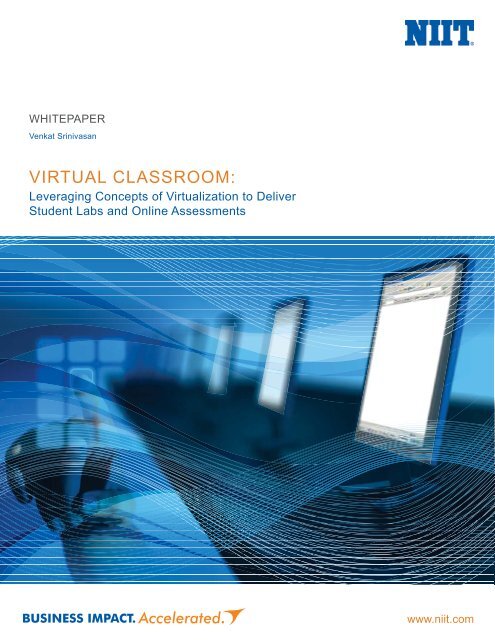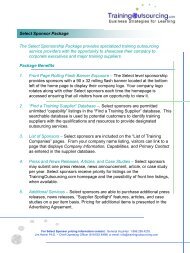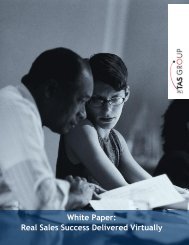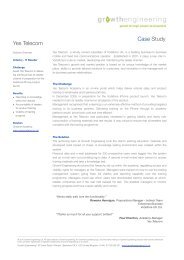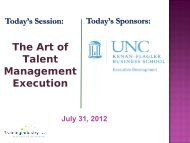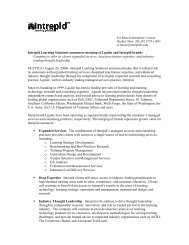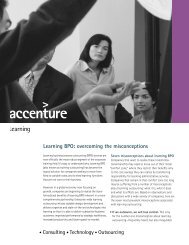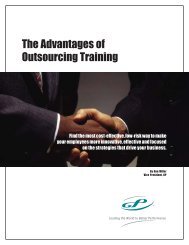NIIT WP Virtual Classroom - IT Training - TrainingIndustry.com
NIIT WP Virtual Classroom - IT Training - TrainingIndustry.com
NIIT WP Virtual Classroom - IT Training - TrainingIndustry.com
Create successful ePaper yourself
Turn your PDF publications into a flip-book with our unique Google optimized e-Paper software.
WH<strong>IT</strong>EPAPER<br />
Venkat Srinivasan<br />
VIRTUAL CLASSROOM:<br />
Leveraging Concepts of <strong>Virtual</strong>ization to Deliver<br />
Student Labs and Online Assessments<br />
BUSINESS IMPACT.<br />
Accelerated.<br />
www.niit.<strong>com</strong>
INTRODUCTION<br />
Fueled by current economic conditions, colleges and universities are experiencing an<br />
unprecedented surge in enrollment. Online education and programs offering technical<br />
degrees and certification are particularly attractive to new students, as evidenced<br />
by leaders like <strong>IT</strong>T Education Services, Inc., which reported a 33.5% enrollment<br />
increase in Q2 2009. 1 While this spike presents exciting new growth opportunities, it<br />
also underscores an escalating challenge: how to efficiently and effectively meet the<br />
demands of a growing student population.<br />
To ac<strong>com</strong>plish this, institutions of higher education are turning to virtualization,<br />
one of the hottest technologies in <strong>IT</strong> infrastructure.2 By deploying virtualization,<br />
and particularly virtual desktop labs, schools can provide <strong>IT</strong> students with superior<br />
learning experiences that prepare them for an increasingly connected—and digitally<br />
mediated—civic life. <strong>Virtual</strong>ization also eliminates the need to maintain and manage<br />
large, expensive systems across several campuses, giving colleges and universities a<br />
scalable, cost-effective solution that supports next-generation learning, assessment,<br />
and development.<br />
This whitepaper reveals how colleges and universities can leverage virtual labs<br />
(vLabs), or virtualization technology, to improve operational efficiencies, reduce<br />
overhead and technology-related expenses, and position themselves as leaders in<br />
the higher education sector. Ultimately, institutions will learn how to harness the<br />
power of virtualization to revolutionize performance-based assessments by capturing,<br />
disseminating, and refining information faster—and more efficiently—than ever<br />
before, thereby be<strong>com</strong>ing models of higher education that attract more students,<br />
employers, and accrediting and funding bodies.<br />
2<br />
WH<strong>IT</strong>EPAPER<br />
www.niit.<strong>com</strong><br />
<strong>Virtual</strong> <strong>Classroom</strong>
UNIVERS<strong>IT</strong>Y <strong>IT</strong> LAB TRENDS<br />
While the concept of virtualization is growing in popularity, schools seem reluctant<br />
to integrate true, hands-on virtual lab technology into their infrastructure. As<br />
Cathy Davidson writes in the The Future of Learning Institutions in a Digital Age,<br />
“Institutions of higher learning have changed more slowly than the modes of<br />
inventive, collaborative, participatory learning offered by the Internet and an array<br />
of contemporary mobile technology.” 3 Self study and e-learning courses do utilize<br />
technology to give students greater flexibility, but this asynchronous method of<br />
study does not facilitate active participation. And online collaborative learning,<br />
which extends beyond self-study to include web-based conferencing tools and allows<br />
students to participate with their peers, still fails to engage students in a way that<br />
can boost retention rates. 4, 5<br />
To encourage active participation among students—and thus boost retention—<br />
institutions need to foster a virtual environment that gives students hands-on<br />
experiences and allows them to assess and master the skills necessary to<br />
thrive in the “real world.”<br />
To encourage active participation among students—and thus boost retention—<br />
institutions need to foster a virtual environment that gives students hands-on<br />
experiences and allows them to assess and master the skills necessary to thrive<br />
in the “real world.” Some colleges and universities have launched experimental<br />
forms of virtualization—with successful results. In 2007, Professor Ed Lamoureux<br />
of Bradley College started a course entitled Field Research Methods in Second Life,<br />
which was conducted entirely in the virtual world format of the popular game Second<br />
Life.3 Monroe College also integrated Second Life into its curriculum, requiring<br />
most students to <strong>com</strong>plete one or two full semester internships through the virtual<br />
internship program. This interactive learning portal proved so successful, interns<br />
cultivated networking opportunities that, in two cases during the program’s first year,<br />
led to employment. 6<br />
WH<strong>IT</strong>EPAPER<br />
<strong>Virtual</strong> <strong>Classroom</strong><br />
3<br />
www.niit.<strong>com</strong>
“<strong>Virtual</strong>ization is<br />
the highest impact<br />
trend changing<br />
infrastructure and<br />
operations through<br />
2012. It will change<br />
how you manage,<br />
how and what you<br />
buy, how you deploy,<br />
how you plan, and<br />
how you charge.”<br />
All of this is made possible through virtualization, a trend that<br />
continues to grow—and is sure to escalate—for institutions of<br />
higher learning as well as the field of Information Technology itself.<br />
According to a 2006 Gartner Special Report, “<strong>Virtual</strong>ization is the<br />
highest impact trend changing infrastructure and operations through<br />
2012. It will change how you manage, how and what you buy, how<br />
you deploy, how you plan, and how you charge.” 7 A 2008 Citrix<br />
survey, conducted at the annual EDUCAUSE conference in Orlando,<br />
Florida, indicates that an overwhelming percentage of higher<br />
education <strong>IT</strong> experts are interested in adding virtual desktop delivery<br />
to their institution’s virtualization profile.8 And research firm IDC<br />
predicts that 45 percent of servers will be virtualized by the end of<br />
2009—a 23 percent jump from just 18 months prior. 9<br />
<strong>Virtual</strong>ization, which essentially allows multiple servers to fit on<br />
one machine, enables colleges to increase server utilization and<br />
thus reduce the manpower and resources needed to manage and maintain several<br />
servers across disparate campuses. In addition to giving students greater flexibility<br />
with 24/7 access, virtualization also requires lower operating costs than traditional<br />
methods of <strong>IT</strong> deployment. As a result, colleges and universities gain the freedom<br />
to test and refine new courses without having to maintain physical labs or costly<br />
upgrade equipment.<br />
Businesses have already seen impressive savings through virtualization. According<br />
to a recent IDC study, 88 percent of U.S.-based organizations saved 20 percent of<br />
capital expenditures by employing virtualization.10 This holds true for institutions<br />
of higher education that were early adopters of virtualization. Art Gloster, vice<br />
president for information services at Bryant University, reported that the school<br />
saved an estimated $35,000 in the four years since implementing virtualization<br />
technology. 11 WH<strong>IT</strong>EPAPER<br />
<strong>Virtual</strong> <strong>Classroom</strong><br />
4<br />
www.niit.<strong>com</strong>
vLabs technology<br />
offers far-reaching<br />
benefits that can<br />
help institutions<br />
ac<strong>com</strong>plish this by<br />
keeping pace with<br />
the business sector<br />
and preparing<br />
students for realworld<br />
scenarios.<br />
What businesses have realized is that the exchange of ideas no<br />
longer relies on the contiguity of time and space; learning and<br />
innovation are happening all the time—through online portals and<br />
collaborative sites—and success now hinges on the ability to foster<br />
and capture the best of those myriad ideas. This is all made possible<br />
by deploying virtualization strategies and technologies. If colleges<br />
and universities are to continue to produce employable graduates<br />
who are not only adept, but also capable of transforming these<br />
technologies, they have to mirror the evolution happening in the<br />
business world. Essentially, they must revitalize current forms of<br />
learning to show students how to leverage virtual channels to thrive<br />
in a connected, collaborative environment.<br />
vLabs technology offers far-reaching benefits that can help<br />
institutions ac<strong>com</strong>plish this by keeping pace with the business sector<br />
and preparing students for real-world scenarios. Colleges and universities will be able<br />
to capture the significant cost-savings that several organizations and, increasingly,<br />
institutions of higher education, are realizing. By providing anytime, anyplace access<br />
for students in a way that fosters participatory learning, and allowing colleges and<br />
universities to centralize hardware, save on administrative and capital costs, and<br />
achieve faster ROI, vLabs can give schools the next-generation solutions they need<br />
to adapt to a more connected, digitized world.<br />
Colleges and universities will be able to capture the significant cost-savings<br />
that several organizations and, increasingly, institutions of higher education,<br />
are realizing. By providing anytime, anyplace access for students in a way that<br />
fosters participatory learning, and allowing colleges and universities to centralize<br />
hardware, save on administrative and capital costs, and achieve faster ROI,<br />
vLabs can give schools the next-generation solutions they need to adapt to a<br />
more connected, digitized world.<br />
WH<strong>IT</strong>EPAPER<br />
<strong>Virtual</strong> <strong>Classroom</strong><br />
5<br />
www.niit.<strong>com</strong>
LEVERAGING CONCEPTS OF VIRTUALIZATION TO DELIVER<br />
<strong>IT</strong> STUDENT LABS AND ONLINE PERFORMANCE ASSESSMENTS<br />
HOW VLABS WORKS:<br />
VLABS<br />
BENEF<strong>IT</strong>S:<br />
Increased Innovation<br />
n Real-time lab<br />
environment<br />
n Reduced costs<br />
<strong>com</strong>pared to tradition<br />
<strong>IT</strong> infrastructure<br />
n Delivers scenarios<br />
based on Microsoft,<br />
Cisco, Linux, and other<br />
systems<br />
Enhanced, Experiential<br />
Learning<br />
n Hands-on virtual<br />
environments replicate<br />
a real-life working<br />
environment<br />
n Scalable 24/7 access<br />
to live networking<br />
hardware and software<br />
n Gives students<br />
scheduling flexibility/<br />
self-paced learning<br />
environment<br />
vLabs provides a dedicated, real-time lab environment without the<br />
risks of costly technological investments associated with traditional<br />
<strong>IT</strong> deployment. Instead of relying on several servers running across<br />
various physical locations, vLabs provides a dedicated, real-time lab<br />
environment without the risks of costly technological investments<br />
associated with traditional <strong>IT</strong> deployment. Instead of relying on<br />
several servers running across various physical locations, vLabs<br />
servers are hosted in a single data center. The schools themselves<br />
are not required to maintain the infrastructure.<br />
Below is a brief overview of the vLabs process:<br />
n Students are free to choose when to use vLabs, which typically<br />
run for 60 minutes<br />
n Every vLab includes a detailed breakdown of objectives to be met<br />
and tasks to be <strong>com</strong>pleted<br />
n Instructors can choose to provide real-time virtual assistance<br />
n Students can verify results at the end of labs by using a selfassessment<br />
feature<br />
n Lab reports with students’ responses and embedded screenshots<br />
are sent to instructors for grading<br />
Improved Assessments<br />
n Allows for real-time<br />
feedback<br />
n Facilitates more<br />
responsive educational<br />
environment<br />
Figure<br />
1: vLab<br />
embedded edded<br />
within<br />
a course.<br />
WH<strong>IT</strong>EPAPER<br />
<strong>Virtual</strong> <strong>Classroom</strong><br />
6<br />
www.niit.<strong>com</strong>
Clearly then, vLabs<br />
will enhance student<br />
learning in a way<br />
that benefits not only<br />
the learners, but<br />
also the employers<br />
who hire them,<br />
and the colleges<br />
and universities<br />
that provided them<br />
STUDENT EXPECTATIONS<br />
Studies show that experiential learning enables students to retain<br />
more knowledge than they do in lecture-based environments. 12<br />
This<br />
heightened retention gives students the confidence they need to<br />
individually perform <strong>com</strong>plex tasks in the workplace—and increases<br />
the likelihood that graduates will not require extensive on-the-job<br />
training. This is why colleges and universities must move beyond<br />
environments that merely simulate an actual <strong>IT</strong> environment,<br />
such as e-learning and passive online collaboration, if they want<br />
to adequately prepare their students for real-world applications,<br />
working scenarios and work place success.<br />
with the innovative,<br />
Hands-on <strong>IT</strong> experiences—the crucial ingredient in cultivating<br />
translatable<br />
confident, highly skilled professionals —are central to vLabs. With<br />
education designed the benefit of real-time interaction, students can quickly assess<br />
to meet real-world their own skills, strengths, and weaknesses, and work on areas<br />
expectations.<br />
that need improvement prior to graduation. As Lucinda Willis,<br />
assistant professor of technology and training at Indiana University<br />
of Pennsylvania points out, <strong>IT</strong> students can leverage virtual training<br />
to “prove they can do hands-on stuff before they learn how to<br />
assist someone [as part of a corporate help desk].” She uses this analogy: “It’s like<br />
when you learn to bake a cake—you can’t do anything unless you prove that you<br />
understand what all the measurement tools are.” 4<br />
Looking back on Monroe College’s Second Life internship program, one can see how<br />
experiential-based learning translates into employability with little training required.<br />
According to Professor John McMullen, who helped pioneer the program, this<br />
technology put students at the cutting edge: “They won’t only be doing research, but<br />
they’ll be developing tools that will make them more employable.” 13<br />
Clearly then, vLabs will enhance student learning in a way that benefits not only the<br />
learners, but also the employers who hire them, and the colleges and universities<br />
that provided them with the innovative, translatable education designed to meet<br />
real-world expectations.<br />
7<br />
WH<strong>IT</strong>EPAPER<br />
www.niit.<strong>com</strong><br />
<strong>Virtual</strong> <strong>Classroom</strong>
<strong>IT</strong> LAB CHALLENGES IN HIGHER EDUCATION<br />
There are of course myriad challenges presented by traditional <strong>IT</strong> labs and largescale<br />
technology deployment. These include physical limitations such as having an<br />
inadequate number of desktops to serve a growing student population, resource<br />
limitations that prevent 24/7 maintenance and lab support for students, and<br />
prohibitive costs that must <strong>com</strong>pete with shrinking budgets. Deploying <strong>com</strong>plex<br />
vertical <strong>IT</strong> systems at multi-campus schools is expensive, and puts colleges and<br />
universities in a vulnerable position: how can school administrators decide between<br />
the value of rolling out the latest technology versus the costly overhead required to<br />
do so? Will they have the resources to manage a wide range of operating systems<br />
and applications? And if they do implement large, <strong>com</strong>plex systems, can they risk<br />
losing their sizeable investment if the system fails?<br />
While there are no hard and fast answers to any of these questions, schools that<br />
utilize virtualization will no longer need to grapple with these tough decisions. In the<br />
aforementioned 2008 Citrix study, higher education professionals cited “<strong>com</strong>puter<br />
lab challenges” as one of the most important virtualization issues facing colleges<br />
and universities today. Of the respondents, 62 percent believed that deploying<br />
virtual <strong>com</strong>puter labs would help address this issue by reducing the costs associated<br />
with maintaining physical lab equipment. Additionally, more than half agreed that<br />
virtualization would “make their institution more <strong>com</strong>petitive,” presumably because<br />
such a technology would simplify the delivery of semester-based instructional<br />
applications and resources. 8<br />
8<br />
WH<strong>IT</strong>EPAPER<br />
www.niit.<strong>com</strong><br />
<strong>Virtual</strong> <strong>Classroom</strong>
A DYNAMIC PERFORMANCE ASSESSMENT TOOL<br />
Teachers have the difficult task of performing as both coach and non-judgmental<br />
mentor, and being equally adept at scrutinizing student performance to see if they<br />
“measure up” or “make the grade.” This challenge is exacerbated by inefficient<br />
assessment techniques, requiring teachers to conduct labor-intensive grade logging<br />
and maintain a question bank for thousands of test items.<br />
While aligning student out<strong>com</strong>es with course objectives is an ongoing challenge,<br />
the fact that most institutions still rely on pen and paper testing only makes things<br />
worse. As Cathy Davidson points out, educational institutions are still “holding<br />
desperately to the fragments of an educational system, which, in its form, content,<br />
and assessments, is deeply rooted in an antiquated mode of learning.” 3<br />
Below is an illustration of the current method of imparting in-class assessments:<br />
Figure 2: A Microsoft vLab in progress<br />
9<br />
WH<strong>IT</strong>EPAPER<br />
www.niit.<strong>com</strong><br />
<strong>Virtual</strong> <strong>Classroom</strong>
LEVERAGING CONCEPTS OF VIRTUALIZATION TO DELIVER<br />
<strong>IT</strong> STUDENT LABS AND ONLINE PERFORMANCE ASSESSMENTS<br />
How can schools meet a constantly evolving student body or report accurate<br />
assessment figures to accreditation boards when depending on archaic technology?<br />
With vLabs, students can see whether they are meeting course expectations,<br />
instructors can ensure that course curriculum is aligned with lab and overall school<br />
objectives, and institutions can determine the effectiveness of any program—and<br />
remain accountable for educational quality.<br />
With vLabs, students can see whether they are meeting course expectations,<br />
instructors can ensure that course curriculum is aligned with lab and overall<br />
school objectives, and institutions can determine the effectiveness of any<br />
program—and remain accountable for educational quality.<br />
A case in point centers on Professor Bill Reay at Ohio State University, who uses<br />
virtualization technologies to not only assess student performance, but his own.<br />
He says that being able to constantly monitor student test results and even<br />
<strong>com</strong>municate with them via interactive forums or sessions is “a great way for me to<br />
get a sense of how many students understand a particular concept before I move<br />
on. It helps me get a sense of what needs explaining, and helps them understand<br />
everything as best they can.” 4<br />
This method allows teachers and students to <strong>com</strong>municate in entirely new ways,<br />
revealing how students really live up and respond to course expectations as opposed<br />
to referencing static, letter grades that can’t reflect the full “story” of learning. As<br />
Trent Batson put it in his article Why Do We Assess?, “If our entire assessment …<br />
started with students telling more of their story in a way that lends itself to building<br />
data structures, the entire system would produce much more valuable information<br />
for researchers, assessment experts, institutional research offices, and accrediting<br />
agencies.” 14<br />
vLabs can bring this “storytelling” process to life. While the aforementioned benefits<br />
of vLabs would be attractive to any organization, this technology goes beyond<br />
providing enhanced learning for students and reduced institutional expenses. It also<br />
provides a revolutionary approach to performance-based assessments that results<br />
in more valuable educational experiences for students and faculty, curriculum that’s<br />
better aligned with institutional objectives, and finally, poises the school to receive<br />
increased funding and achieve greater profitability.<br />
WH<strong>IT</strong>EPAPER<br />
<strong>Virtual</strong> <strong>Classroom</strong><br />
10<br />
www.niit.<strong>com</strong>
THE ASSESSMENT PROCESS<br />
vLabs eliminate the tedious tasks associated with traditional pen and paper<br />
assessment practices. With anytime, anyplace access, teachers can manage<br />
proctored exams without having to physically disseminate and collect tests, and<br />
painstakingly grade and log results. These labs can be integrated into online offerings<br />
or with on-campus courses for a blended learning platform that fosters deeper<br />
student engagement.<br />
How the vLabs assessment process works:<br />
This process helps<br />
teachers capture near<br />
real-time information<br />
about student<br />
performance, while<br />
also allowing students<br />
to monitor and assess<br />
their own strengths and<br />
pinpoint areas which<br />
may need improvement.<br />
Because this process is<br />
essentially instantaneous,<br />
both students and faculty<br />
are provided with real<br />
skills-based assessment—<br />
vital for thriving in<br />
today’s digitized world.<br />
1) Student lab reports are delivered to the instructor upon lab<br />
<strong>com</strong>pletion.<br />
2) Teachers can determine a grade for each student based on<br />
individual lab reports that reflect student performance.<br />
Below is an illustration of system-based assessments:<br />
Figure 3: Opening a remote console window for Microsoft device<br />
WH<strong>IT</strong>EPAPER<br />
<strong>Virtual</strong> <strong>Classroom</strong><br />
11<br />
www.niit.<strong>com</strong>
LEVERAGING CONCEPTS OF VIRTUALIZATION TO DELIVER<br />
<strong>IT</strong> STUDENT LABS AND ONLINE PERFORMANCE ASSESSMENTS<br />
SIX BENEF<strong>IT</strong>S VLABS PROVIDES FOR HIGHER<br />
EDUCATION INST<strong>IT</strong>UTIONS<br />
We have already seen how businesses have reaped significant cost-savings<br />
advantages by deploying virtualization across organizations. And while educational<br />
institutions operate in a similar manner to most businesses, they face additional<br />
<strong>com</strong>plex challenges such as finding ways to manage massive amounts of information,<br />
serving an influx of hundreds or thousands of students every few months, and<br />
constantly having to refurbish or replace technology for new students each year.<br />
Colleges and universities can over<strong>com</strong>e these challenges through the use of vLabs,<br />
which allow them to:<br />
1. Enhance student learning environment<br />
2. Gain a <strong>com</strong>petitive edge in the <strong>IT</strong> education market<br />
3. Drive new enrollment<br />
4. Improve assessments<br />
5. Reach profitability goals faster<br />
6. Attract funding by implementing “greener” technologies<br />
12<br />
WH<strong>IT</strong>EPAPER<br />
www.niit.<strong>com</strong><br />
<strong>Virtual</strong> <strong>Classroom</strong>
Enhance Student Learning Environment<br />
The average attrition rate in higher education is a whopping 50 percent. To<br />
<strong>com</strong>bat this, many colleges and universities invest in minimal software upgrades<br />
or implement procedural changes in an attempt to better connect with students—<br />
both with lackluster results. By integrating vLabs into the curriculum, schools can<br />
establish continuous contact with <strong>IT</strong> students in a simple, cost-effective way that<br />
improves the learning experience. With experiential-based learning, students are<br />
more inclined to engage and remain dedicated to <strong>com</strong>pleting their courses of study.<br />
Because vLabs are customizable, schools are free to decide how vLabs are designed,<br />
thereby ensuring brand integrity and maintaining the ability to embed their unique<br />
pedagogy within the technological framework. This consistency and strength in<br />
branding will help students internalize what makes the school uniquely valuable, and<br />
increases the likelihood that they will make a stronger, more engaged effort in all<br />
academic—and, consequently, all work-related—pursuits.<br />
Figure 4: A Cisco vLab in progress<br />
13<br />
WH<strong>IT</strong>EPAPER<br />
www.niit.<strong>com</strong><br />
<strong>Virtual</strong> <strong>Classroom</strong>
LEVERAGING CONCEPTS OF VIRTUALIZATION TO DELIVER<br />
<strong>IT</strong> STUDENT LABS AND ONLINE PERFORMANCE ASSESSMENTS<br />
Gain a Competitive Edge in the <strong>IT</strong> Education Market<br />
Remaining <strong>com</strong>petitive is especially critical during turbulent economic times. Schools<br />
that can attract and retain students in downward or stagnant economies can<br />
continue to boost their reputation, which in turn increases the likelihood of continued<br />
funding from private and/or public resources. And institutions that can adequately<br />
prepare students for integrated and collaborative working situations produce more<br />
employable students, which, in turn, garners more positive attention from not only<br />
accreditation and funding bodies, but top-tier employers that increasingly turn<br />
toward these institutions to find future employees. An added benefit includes a<br />
reduction in <strong>IT</strong> and equipment expenditures, which can help make institutions more<br />
<strong>com</strong>petitive.<br />
Drive New Enrollment<br />
Having state-of-the-art technology drives growth by attracting <strong>IT</strong>-savvy students.<br />
As they are already immersed in technology, students of the millennial generation<br />
are drawn to schools known for their high-tech capabilities and ability to prepare<br />
students for <strong>IT</strong> positions. vLabs brings colleges and universities up to speed by<br />
integrating the latest technologies in dynamic new ways that heighten hands-on<br />
learning experiences.<br />
Improve Assessments<br />
“What gets measured gets our attention, gets funding, and gets taught.” 15<br />
That<br />
statement, made by The Center for Public Policy in Higher Education in 2006, is an<br />
axiom by which institutions of higher learning must operate. Particularly now, in an<br />
era of increasing scrutiny and shrinking budgets, providing evidence that a school’s<br />
pedagogical goals are being met is critical. vLabs allows colleges and universities<br />
to capture student performance, assess whether course objective are being met,<br />
and refine courses to better meet the needs of a rapidly expanding and often widely<br />
dispersed student population. All of this can happen in near real-time, allowing<br />
schools to make changes that quickly boost performance, and ultimately, garner the<br />
necessary funding and accreditation to thrive in an increasingly <strong>com</strong>petitive market.<br />
14<br />
WH<strong>IT</strong>EPAPER<br />
www.niit.<strong>com</strong><br />
<strong>Virtual</strong> <strong>Classroom</strong>
Reach Profitability Goals Faster<br />
Because of the relatively low expenses associated with vLabs deployment, schools<br />
can reduce technology, equipment, and personnel expenditures. In addition to<br />
lowering <strong>IT</strong>, hardware, and administrative costs, colleges and universities can also<br />
decrease licensing costs. This, <strong>com</strong>bined with increased student attraction and<br />
retention through cutting-edge technology, helps institutions do what might seem<br />
impossible in today’s economy: meet or even exceed revenue and profitability goals.<br />
Because of the relatively low expenses associated with vLabs deployment,<br />
schools can reduce technology, equipment, and personnel expenditures.<br />
In addition to lowering <strong>IT</strong>, hardware, and administrative costs, colleges and<br />
universities can also decrease licensing costs. This, <strong>com</strong>bined with increased<br />
student attraction and retention through cutting-edge technology, helps<br />
institutions do what might seem impossible in today’s economy: meet or even<br />
exceed revenue and profitability goals.<br />
Attract Funding By Implementing Greener Technologies<br />
Increasingly, grants and other sources of funding are be<strong>com</strong>ing available to<br />
organizations and institutions that implement sustainable technologies into their<br />
infrastructure. The Kresge Foundation, a private, national organization, is awarding<br />
grants to colleges and universities that build environmentally sustainable facilities;<br />
the U.S. Environmental Protection Agency provides funding for institutions that<br />
integrate environmental initiatives; businesses and organizations like the Student<br />
Conservation Society (sponsored by NBC) and BP have designed energy grants<br />
and greening contests. As the paradigm has shifted to recognize and reward<br />
organizations and institutions that make a <strong>com</strong>mitment to sustainable practices and<br />
technologies, it is likely that this trend toward funding green initiatives will continue.<br />
Institutions can capitalize on this trend by deploying vLabs, as unlike most largescale<br />
<strong>IT</strong> deployment, vLabs is both cost-effective and green. Because it provides<br />
a centralized service, vLabs requires less energy than heavily energy-dependent<br />
technologies dispersed across disparate networks, thus reducing CO2 emissions.<br />
Colleges and universities can not only cut costs by integrating vLabs technology, but<br />
can also be recognized as leaders in green technology and attract more funding from<br />
eco-conscious businesses and organizations.<br />
WH<strong>IT</strong>EPAPER<br />
<strong>Virtual</strong> <strong>Classroom</strong><br />
15<br />
www.niit.<strong>com</strong>
LEVERAGING CONCEPTS OF VIRTUALIZATION TO DELIVER<br />
<strong>IT</strong> STUDENT LABS AND ONLINE PERFORMANCE ASSESSMENTS<br />
CONCLUSION<br />
Meeting the demands of digitally adept student population requires new technologies<br />
that break traditional paradigms. Schools are still largely operating on the same<br />
foundations—with the same technologies—as they have since the first university was<br />
established more than 200 years ago. By implementing a vLab model for hands-on<br />
training and education, institutions of higher education can shatter those boundaries<br />
and create dynamic new ways of engaging with, assessing, and preparing students<br />
for a successful transition into the working world. Ultimately, colleges and universities<br />
can broaden and streamline technology program offerings, reduce overhead<br />
associated with <strong>IT</strong> expansion and maintenance with less risk than traditional <strong>IT</strong>related<br />
investments, and prepare our next generation of leaders by constantly<br />
refining curricula with radically improved performance-based assessments.<br />
To learn more about vLabs, please visit:<br />
n vLab online demo: http://knowledge.elementk.<strong>com</strong>/keycode/dm_offerprice_<br />
presentation.jsp?keycode=DEMOVLAB44320933<br />
n http://niit.<strong>com</strong>/LearningSolutions/Learning%20SolutionforHigherEducationInsitu<br />
tions/Pages/<strong>Virtual</strong>Labs.aspx<br />
16<br />
WH<strong>IT</strong>EPAPER<br />
www.niit.<strong>com</strong><br />
<strong>Virtual</strong> <strong>Classroom</strong>
ABOUT <strong>NI<strong>IT</strong></strong><br />
<strong>NI<strong>IT</strong></strong>’s Enterprise Learning Solutions Company delivers innovative strategies that<br />
help clients accelerate business impact. Our clients count on our Managed <strong>Training</strong><br />
Services specifically in the areas of advisory and learning services, technology tools,<br />
and custom content to optimize their learning organizations and to improve time to<br />
performance for employees, customers and partners.<br />
We use cutting-edge instructional design and our Critical Mistake Analysis method<br />
to deliver award-winning solutions, technology and services. Together with our<br />
subsidiaries, Cognitive Arts and Element K, our Global Talent Development programs<br />
help clients achieve real-world skills to better <strong>com</strong>pete in today’s market.<br />
Established in 1981, <strong>NI<strong>IT</strong></strong> is known globally as the number one choice for strategic<br />
learning solutions. We proudly partner with the world’s leading education,<br />
technology, publishing and Fortune 500 <strong>com</strong>panies. <strong>NI<strong>IT</strong></strong> has won over 40 awards,<br />
including 12 Brandon Hall awards.<br />
ABOUT VENKAT SRINIVASAN<br />
Venkat Srinivasan has over 15-years experience in business strategy, new business<br />
development, strategic relationship management, and operations in the education<br />
and training industry. His insight into the business of higher education, and<br />
experience designing and developing learning and student retention solutions for<br />
institutions truly set him apart from others in his field. Venkat started out as part of<br />
the <strong>NI<strong>IT</strong></strong> faculty, and went on to design and develop various new programs, including<br />
increasing student retention and reducing attrition rates by 50%. Venkat now works<br />
as Vice President for <strong>NI<strong>IT</strong></strong>.<br />
n Look out for his blog - http://www.niit.<strong>com</strong>/highereducationblog/default.aspx.<br />
17<br />
WH<strong>IT</strong>EPAPER<br />
www.niit.<strong>com</strong><br />
<strong>Virtual</strong> <strong>Classroom</strong>
REFERENCES<br />
1. PR Newswire (Press Release). “<strong>IT</strong>T Education Services, Inc. Reports 2009 Second Quarter<br />
Results, New Student Enrollment Increased 33.5%; EPS Increased 55.8% to $1.87.” PR<br />
Newswire Distribution. 23 July 2009 http://news.prnewswire.<strong>com</strong>/DisplayReleaseContent.<br />
aspx?ACCT=ind_focus.story&STORY=/www/story/07-23-2009/0005064851&EDATE.<br />
2. Intel Corporation. “Leading <strong>Virtual</strong>ization 2.0, How Intel is driving virtualization beyond<br />
consolidation into a solution for maximizing business agility within the enterprise.”<br />
http://74.125.155.132/search?q=cache:5XWOT26WlpcJ:download.intel.<strong>com</strong>/technology/<br />
virtualization/leading_virtualization2-0_<strong>WP</strong>.pdf+Leading+<strong>Virtual</strong>ization+2.0,+How+Intel+i<br />
s+driving+virtualization+beyond+consolidation+into+a+solution+for+maximizing+busine<br />
ss+agility+within+the+enterprise.%E2%80%9D&cd=1&hl=en&ct=clnk&gl=us.<br />
3. Davidson, Cathy. “The Future of Learning Institutions in a Digital Age.” John D. and<br />
Catherine T. MacArthur Foundation. 2009.<br />
4. Bhattacharya, Ameet. “Hands-on Experience with <strong>Virtual</strong> labs: <strong>Virtual</strong> production<br />
environments for safe, affordable technology training.” Element K Corporation. 2008.<br />
5 Villano, Matt. “Choose One from Column B.” Campus Technology. 1 March 2007.<br />
http://campustechnology.<strong>com</strong>/issues/2007/march-2007.aspx.<br />
6. Angel Learning. “The Power of <strong>Virtual</strong> Worlds in Education: A Second Life Primer and<br />
resource for Exploring the Potential of <strong>Virtual</strong> Worlds to Impact Teaching and Learning.”<br />
July 2008.<br />
7. Dawson, Philip. “<strong>Virtual</strong>ization changes everything.” Gartner Special Report. 26 March<br />
2008. http://www.gartner.<strong>com</strong>/DisplayDocument?doc_cd=156488.<br />
9. Ferguson, Scott. “<strong>Virtual</strong>ization Evolves into Disaster Recovery Tool.” eWeek. 7 May<br />
2008. http://www.eweek.<strong>com</strong>/c/a/<strong>IT</strong>-Infrastructure/<strong>Virtual</strong>ization-Evolves-into-Disaster-<br />
Recovery-Tool/.<br />
10. IDC Multiclient Study. “Server <strong>Virtual</strong>ization on the Move 2007: Foundation in the Dynamic<br />
Data Center.” July 2007.<br />
11. Villano, Matt. “At Your <strong>Virtual</strong> Service.” Campus Technology. 1 March 2008.<br />
http://www.campustechnology.<strong>com</strong>/Articles/2008/03/At-Your-<strong>Virtual</strong>-Service.aspx.<br />
12. Arnold, Julie. “Hands-on Learning for Freshman Engineering Students.” 2003.<br />
http://www.istl.org/03-spring/article3.html.<br />
13. Monroe College. “Monroe Goes <strong>Virtual</strong>.” 2007. http://www.monroecollege.edu/<br />
aboutmonroe/news/archives/2007/mcgoesvirtual<br />
14. Batson, Trent. “Why Do We Assess?” Campus Technology. 1 July 2009.<br />
http://www.campustechnology.<strong>com</strong>/Articles/2009/07/01/Why-We-Assess.aspx.<br />
15. The Center for Public Policy and Higher Education. “Measuring up 2006: The National<br />
Report Card on Higher Education,” September 2006.<br />
http://measuringup.highereducation.org.<br />
18<br />
WH<strong>IT</strong>EPAPER<br />
www.niit.<strong>com</strong><br />
<strong>Virtual</strong> <strong>Classroom</strong>


